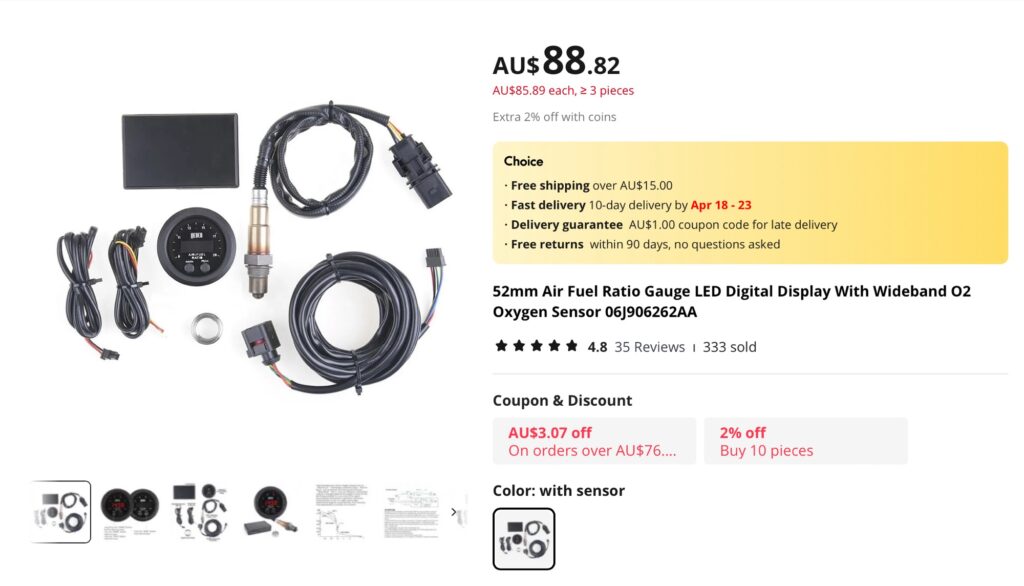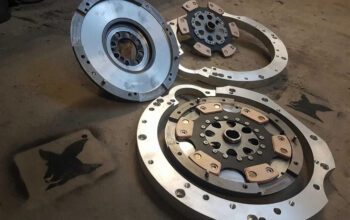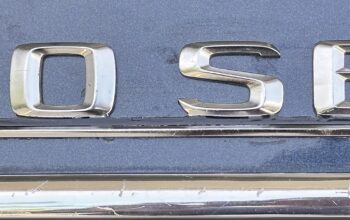In my relentless pursuit of a perfectly running M116 V8, I’ve turned my attention to the ignition timing as well as the K-Jet fuel mixture on my 380SEC. For months I’ve been fiddling with the mixture never really knowing if I’ve got it right or not as I never had a way quantify it. I was also quite sternly told by my previous mechanic to never touch the mixture screw – challenge accepted!
CO% Emissions
On the front crossmember of the car there is an emissions compliance sticker that states the amount of CO% that the car should be producing. If I can tune the car to this figure, I should in theory have a sweet running engine.

According to this label, the car should be producing 0.7-1.3% CO with the car in neutral, air injection disconnected and timing set to 5 degrees @ 750rpm. I’ll also note, that the vacuum retard on the distributor should be connected and the air conditioning switched off.
This is great, but how do I measure the CO%? Old school CO gauges are no longer readily available despite a thorough search of the internet. In an age of EFI and OBD2 scanners, there’s not a lot of need for such a device and many of the ones I did find were $3-500, which I couldn’t justify for something I wont be using very often.
It turns out however that CO% can be converted to an AFR (Air Fuel Ratio) quite easily. To measure the AFR, it’s simply a matter of connecting an O2 sensor to the exhaust and then connecting that to a gauge.
Initially I made a mistake of ordering a $20 O2 sensor and AFR gauge thinking this would be enough to do the job. Unfortunately when they arrived, the instructions showed that it needs an ECU of some sort to sit in the middle. FAIL!
I did another search online and found another O2 sensor and gauge, but this one came with a little black box to convert the readings from the O2 sensor to a signal the gauge can understand. This one cost me $70 – a $50 premium for that little black box.

While I was waiting for the new gauge to come, I went to my local exhaust shop and had them weld in a bung in the exhaust to allow me to install the new O2 sensor. It was a job that took him about 15 minutes to complete.
When the gauge finally arrived, I hoisted up the car and screwed in the O2 sensor. The O2 sensor is only installed when I’m tuning the car, and there’s a screw plug to take its place at all other times.
I then plugged all the cables into signal converter box, which left me with 2 exposed wires that I attached alligator clips to. These alligator clips then connect to the battery.
Testing and Adjusting
With everything now all hooked up, I was ready to start taking measurements. My initial reading came up around 12.8:1 which is quite a bit more rich than what it should be. A look at the table below shows that 12.8:1 equates to about 4% CO.
| %CO | AFR | %CO | AFR | %CO | AFR |
| 0.1 | 14.72 | 3.5 | 13.2 | 6.9 | 11.93 |
| 0.2 | 14.54 | 3.6 | 13.15 | 7 | 11.89 |
| 0.3 | 14.42 | 3.7 | 13.12 | 7.1 | 11.86 |
| 0.4 | 14.34 | 3.8 | 13.08 | 7.2 | 11.82 |
| 0.5 | 14.28 | 3.9 | 13.03 | 7.3 | 11.79 |
| 0.6 | 14.23 | 4 | 13 | 7.4 | 11.76 |
| 0.7 | 14.21 | 4.1 | 12.96 | 7.5 | 11.72 |
| 0.8 | 14.17 | 4.2 | 12.93 | 7.6 | 11.69 |
| 0.9 | 14.15 | 4.3 | 12.9 | 7.7 | 11.65 |
| 1 | 14.11 | 4.4 | 12.86 | 7.8 | 11.61 |
| 1.1 | 14.09 | 4.5 | 12.83 | 7.9 | 11.58 |
| 1.2 | 14.04 | 4.6 | 12.8 | 8 | 11.54 |
| 1.3 | 14.01 | 4.7 | 12.75 | 8.1 | 11.5 |
| 1.4 | 13.98 | 4.8 | 12.7 | 8.2 | 11.46 |
| 1.5 | 13.94 | 4.9 | 12.66 | 8.3 | 11.43 |
| 1.6 | 13.89 | 5 | 12.64 | 8.4 | 11.4 |
| 1.7 | 13.86 | 5.1 | 12.59 | 8.5 | 11.36 |
| 1.8 | 13.82 | 5.2 | 12.54 | 8.6 | 11.32 |
| 1.9 | 13.8 | 5.3 | 12.51 | 8.7 | 11.28 |
| 2 | 13.77 | 5.4 | 12.46 | 8.8 | 11.25 |
| 2.1 | 13.73 | 5.5 | 12.43 | 8.9 | 11.21 |
| 2.2 | 13.69 | 5.6 | 12.4 | 9 | 11.16 |
| 2.3 | 13.63 | 5.7 | 12.37 | 9.1 | 11.12 |
| 2.4 | 13.59 | 5.8 | 12.3 | 9.2 | 11.08 |
| 2.5 | 13.56 | 5.9 | 12.25 | 9.3 | 11.05 |
| 2.6 | 13.54 | 6 | 12.25 | 9.4 | 11.01 |
| 2.7 | 13.49 | 6.1 | 12.22 | 9.5 | 10.97 |
| 2.8 | 13.45 | 6.2 | 12.18 | 9.6 | 10.94 |
| 2.9 | 13.41 | 6.3 | 12.13 | 9.7 | 10.9 |
| 3 | 13.38 | 6.4 | 12.1 | 9.8 | 10.86 |
| 3.1 | 13.34 | 6.5 | 12.09 | 9.9 | 10.82 |
| 3.2 | 13.31 | 6.6 | 12.03 | 10 | 10.79 |
| 3.3 | 13.27 | 6.7 | 12 | ||
| 3.4 | 13.24 | 6.8 | 11.96 |
The correct range for the car as it was delivered back in 1983 is in the range 14.01 – 14.21:1. I started making minor adjustments and was surprised to find that it only takes about 1/16 of a turn of the screw to change between 12.8 and 14:2. It took the slightest of adjustments to get it just right. It’s important to note that the service manual suggests giving the car a rev to 3500rpm and then letting it settle for a minute before taking a reading. I found that after doing this there was a small variation in the between what I initially had set and what the reading post-revving was.
While doing my research on this, I had heard anecdotally that the Australian delivered 380SEC as it was from the factory was not optimally tuned in order to meet emissions requirements. Many owners back in the day would return the car back to the dealer to have it tuned to Euro specs.
Euro specs in this case means advancing the timing a few degrees and running the mixture slightly richer.
| Australian Spec | Euro Spec | |
| Timing | 5 degrees | 13-19 degrees |
| CO% (AFR) | 0.7-1.3% (14.01 – 14.21) | 1.0-2.0% (14.11-13.77) |
I finally settled on a AFR of 13.8-14.0, but I decided to err on the side of caution with regards to the timing at 5 degrees, however I may experiment with it a little in the future and see how it goes.
Driving Impressions
With everything completed, it was now time for test drive. My first impressions were actually not good! Why? Because I stupidly set the timing with the vacuum line disconnected which meant it was way out. This resulted in stuttering off the line and absolutely no power below 2000rpm. Worse still it was idling OK, but not as good as it should resulting in a very low oil pressure at idle.
I took it back in the garage and fixed my mistake. The car was now idling much smoother and shifted into gear nice and smooth. It’s interesting that when it wasn’t properly tuned it would engage Drive and Reverse with somewhat of a clunk – kind of like what you would expect if the transmission was on its way out, but not it is engaging normally like a healthy transmission.
On the road it feels nice and punchy off the line and willing to rev all the way to the redline without missing a beat. Job done!



